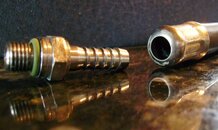49thdiver
Registered
Greetings, first off I am very glad to be posting this message, and I thank my Buddy for being there when I needed him.
From the attached picture you can see a low pressure hose with swage and a hose barb. The hose did have a protector on it at the time I have since removed it to inspect the swage and hose. These two pieces are normally joined togeather for ever and ever amen, you would think. In this particular case however 20 minutes into the dive at 70 FSW, with about 800 lbs of air remaining turning my head to the right to see if my buddy was follwoing to the the ascent line, they decided to part company, something less than 10 seconds later I had NO AIR. This story has a happy ending, my compentent buddy was there as soon as he heard it go off, I am now the proud owner of a 19 cuft pony bottle with back up reg.
I dive a lot this set of regs has 200-300 dives, I look after them, there is no signs of wear or stress.
So far nobody I have talked to has ever heard of this happening before let alone why.
Any ideas comments appreciated.
Lessons Learned : Dive with a buddy, dive with a pony, tell your family and friends you love them and enjoy knowing them.
Peter
From the attached picture you can see a low pressure hose with swage and a hose barb. The hose did have a protector on it at the time I have since removed it to inspect the swage and hose. These two pieces are normally joined togeather for ever and ever amen, you would think. In this particular case however 20 minutes into the dive at 70 FSW, with about 800 lbs of air remaining turning my head to the right to see if my buddy was follwoing to the the ascent line, they decided to part company, something less than 10 seconds later I had NO AIR. This story has a happy ending, my compentent buddy was there as soon as he heard it go off, I am now the proud owner of a 19 cuft pony bottle with back up reg.
I dive a lot this set of regs has 200-300 dives, I look after them, there is no signs of wear or stress.
So far nobody I have talked to has ever heard of this happening before let alone why.
Any ideas comments appreciated.
Lessons Learned : Dive with a buddy, dive with a pony, tell your family and friends you love them and enjoy knowing them.
Peter






